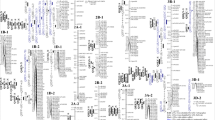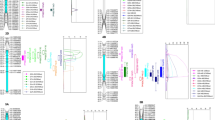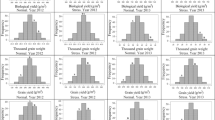Abstract
Quantitative trait loci (QTLs) with additive (a), additive × additive (aa) epistatic effects, and their treatmental interactions (at and aat) were studied under salt stress and normal conditions at seedling stage of wheat (Triticum aestivum L.). A set of 182 recombinant inbred lines (RILs) derived from cross Xiaoyan 54 × Jing 411 were used. A total of 29 additive QTLs and 17 epistasis were detected for 12 traits examined, among which eight and seven, respectively, were identified to have QTL × treatment effects. Physiological traits rather than biomass traits were more likely to be involved in QTL × treatment interactions. Ten intervals on chromosomes 1A, 1D, 2A (two), 2D, 3B, 4B, 5A, 5B and 7D showed overlapping QTLs for different traits; some of them represent a single locus affecting different traits and/or the same trait under both treatments. Eleven pairs of QTLs were detected on seemingly homoeologous positions of six chromosome groups of wheat, showing synteny among the A, B and D genomes. Ten pairs were detected in which each pair was contributed by the same parent, indicating a strong genetic plasticity of the QTLs. The results are helpful for understanding the genetic basis of salt tolerance in wheat and provide useful information for genetic improvement of salt tolerance in wheat by marker-assisted selection.



Similar content being viewed by others
Abbreviations
- CHL:
-
Chlorophyll content (SPAD value)
- MAS:
-
Marker-assisted selection
- N:
-
Normal water treatment
- QTL:
-
Quantitative trait locus
- Q × E :
-
QTL × environment
- Q × T :
-
QTL × treatment
- a :
-
Additive
- aa :
-
Additive × additive
- at :
-
Additive × treatment
- aat :
-
Epistasis × treatment
- RDW:
-
Root dry weight
- RIL:
-
Recombinant inbred line
- RKC:
-
Root K+ concentration
- RKN:
-
Root K+/Na+ concentration ratio
- RL:
-
Root length
- RNC:
-
Root Na+ concentration
- S:
-
Salt stress treatment
- SDW:
-
Shoot dry weight
- SH:
-
Shoot height
- SII:
-
Salt injury index
- SKC:
-
Shoot K+ concentration
- SKN:
-
Shoot K+/Na+ concentration ratio
- SNC:
-
Shoot Na+ concentration
- TDW:
-
Total dry weight
References
Cao G, Zhu J, He C, Gao Y, Yan J, Wu P (2001) Impact of epistasis and QTL × environment interaction on the developmental behavior of plant height in rice (Oryza sativa L.). Theor Appl Genet 103(1):153–160. doi:10.1007/s001220100536
Chhipa BR, Lal P (1995) Na/K ratios as the basis of salt tolerance in wheat. Aust J Agric Res 46(3):533–539
Doebley J, Stec A, Gustus C (1995) Teosinte branched1 and the origin of maize: evidence for epistasis and the evolution of dominance. Genetics 141(1):333–346
Doerge RW (2002) Mapping and analysis of quantitative trait loci in experimental populations. Nat Rev Genet 3(1):43–52
Fan CC, Yu XQ, Xing YZ, Xu CG, Luo LJ, Zhang QF (2005) The main effects, epistatic effects and environmental interactions of QTLs on the cooking and eating quality of rice in a doubled-haploid line population. Theor Appl Genet 110(8):1445–1452. doi:10.1007/s00122-005-1975-y
Foolad MR (1999) Comparison of salt tolerance during seed germination and vegetative growth in tomato by QTL mapping. Genome 42(4):727–734
Foolad MR, Chen FQ (1999) RFLP mapping of QTLs conferring salt tolerance during the vegetative stage in tomato. Theor Appl Genet 99(1–2):235–243
Foolad MR, Zhang LP, Lin GY (2001) Identification and validation of QTLs for salt tolerance during vegetative growth in tomato by selective genotyping. Genome 44(3):444–454
Genc Y, Oldach K, Verbyla AP, Lott G, Hassan M, Tester M, Wallwork H, McDonald GK (2010) Sodium exclusion QTL associated with improved seedling growth in bread wheat under salinity stress. Theor Appl Genet 121(5):877–894. doi:10.1007/s00122-010-1357-y
Gong JM, He P, Qian QA, Shen LS, Zhu LH, Chen SY (1999) Identification of salt-tolerance QTL in rice (Oryza sativa L.). Chin Sci Bull 44(1):68–71
Groos C, Robert N, Bervas E, Charmet G (2003) Genetic analysis of grain protein-content, grain yield and thousand-kernel weight in bread wheat. Theor Appl Genet 106(6):1032–1040. doi:10.1007/s00122-002-1111-1
Gupta PK, Mir RR, Mohan A, Kumar J (2008) Wheat genomics: present status and future prospects. Int J Plant Genomics 2008(Article ID 896451):1–36. doi:10.1155/2008/896451
Han YP, Teng WL, Sun DS, Du YP, Qiu LJ, Xu XL, Li WB (2008) Impact of epistasis and QTL × environment interaction on the accumulation of seed mass of soybean (Glycine max L. Merr.). Genet Res 90(6):481–491. doi:10.1017/S0016672308009865
Hoagland D, Arnon D (1950) The water culture method for growing plants without soil. California Agricultural Experiment Station Circular: 347
Jansen RC, Vanooijen JW, Stam P, Lister C, Dean C (1995) Genotype-by-environment interaction in genetic mapping of multiple quantitative trait loci. Theor Appl Genet 91(1):33–37
Jiang CJ, Zeng ZB (1995) Multiple trait analysis of genetic mapping for quantitative trait loci. Genetics 140(3):1111–1127
Kumar N, Kulwal PL, Balyan HS, Gupta PK (2007) QTL mapping for yield and yield contributing traits in two mapping populations of bread wheat. Mol Breeding 19(2):163–177. doi:10.1007/s11032-006-9056-8
Lee SY, Ahn JH, Cha YS, Yun DW, Lee MC, Ko JC, Lee KS, Eun MY (2006) Mapping of quantitative trait loci for salt tolerance at the seedling stage in rice. Mol Cells 21(2):192–196
Li SS, Jia JZ, Wei XY, Zhang XC, Li LZ, Chen HM, Fan YD, Sun HY, Zhao XH, Lei TD, Xu YF, Jiang FS, Wang HG, Li LH (2007) A intervarietal genetic map and QTL analysis for yield traits in wheat. Mol Breeding 20(2):167–178
Li ZS, Li B, Tong YP (2008) The contribution of distant hybridization with decaploid Agropyron elongatum to wheat improvement in China. J Genet Genomics 35(8):451–456
Liao CY, Wu P, Hu B, Yi KK (2001) Effects of genetic background and environment on QTLs and epistasis for rice (Oryza sativa L.) panicle number. Theor Appl Genet 103(1):104–111
Lin HX, Zhu MZ, Yano M, Gao JP, Liang ZW, Su WA, Hu XH, Ren ZH, Chao DY (2004) QTLs for Na+ and K+ uptake of the shoots and roots controlling rice salt tolerance. Theor Appl Genet 108(2):253–260. doi:10.1007/s00122-003-1421-y
Lindsay MP, Lagudah ES, Hare RA, Munns R (2004) A locus for sodium exclusion (Nax1), a trait for salt tolerance, mapped in durum wheat. Funct Plant Biol 31(11):1105–1114. doi:10.1071/Fp04111
Liu X, Shi J, Zhang XY, Ma YS, Jia JZ (2001) Screening salt tolerance germplasms and tagging the tolerance gene(s) using microsatellite (SSR) markers in wheat. Acta Bot Sin 43(9):948–954
Liu G, Yang J, Xu H, Zhu J (2007) Influence of epistasis and QTL × environment interaction on heading date of rice (Oryza sativa L.). J Genet Genomics 34(7):608–615
Ma LQ, Zhou EF, Huo NX, Zhou RH, Wang GY, Jia JZ (2007a) Genetic analysis of salt tolerance in a recombinant inbred population of wheat (Triticum aestivum L.). Euphytica 153(1–2):109–117
Ma XQ, Tang JH, Teng WT, Yan JB, Meng YJ, Li JS (2007b) Epistatic interaction is an important genetic basis of grain yield and its components in maize. Mol Breeding 20(1):41–51. doi:10.1007/s11032-006-9071-9
Mano Y, Takeda K (1997) Mapping quantitative trait loci for salt tolerance at germination and the seedling stage in barley (Hordeum vulgare L.). Euphytica 94(3):263–272
Marza F, Bai GH, Carver BF, Zhou WC (2006) Quantitative trait loci for yield and related traits in the wheat population Ning7840 × Clark. Theor Appl Genet 112(4):688–698. doi:10.1007/s00122-005-0172-3
Munns R, James RA (2003) Screening methods for salinity tolerance: a case study with tetraploid wheat. Plant Soil 253(1):201–218
Munns R, Tester M (2008) Mechanisms of salinity tolerance. Annu Rev Plant Biol 59:651–681. doi:10.1146/annurev.arplant.59.032607.092911
Pardo JM (2010) Biotechnology of water and salinity stress tolerance. Curr Opin Biotechnol 21(2):185–196. doi:10.1016/j.copbio.2010.02.005
Paterson AH (1995) Molecular dissection of quantitative traits: progress and prospects. Genome Res 5(4):321–333
Peleg Z, Fahima T, Krugman T, Abbo S, Yakir D, Korol AB, Saranga Y (2009) Genomic dissection of drought resistance in durum wheat × wild emmer wheat recombinant inbreed line population. Plant, Cell Environ 32(7):758–779. doi:10.1111/j.1365-3040.2009.01956.x
Pitman MG, Läuchli A (2004) Global impact of salinity and agricultural ecosystems. In: Läuchli A, Lüttge U (eds) Salinity: environment-plants-molecules. Kluwer Academic, Dordrecht, pp 3–20
Prasad SR, Bagali PG, Hittalmani S, Shashidhar HE (2000) Molecular mapping of quantitative trait loci associated with seedling tolerance to salt stress in rice (Oryza sativa L.). Curr Sci India 78(2):162–164
Qi Z, Spalding EP (2004) Protection of plasma membrane K+ transport by the salt overly sensitive1 Na+-H+ antiporter during salinity stress. Plant Physiol 136(1):2548–2555. doi:10.1104/pp.104.049213
Quarrie SA, Steed A, Calestani C, Semikhodskii A, Lebreton C, Chinoy C, Steele N, Pljevljakusic D, Waterman E, Weyen J, Schondelmaier J, Habash DZ, Farmer P, Saker L, Clarkson DT, Abugalieva A, Yessimbekova M, Turuspekov Y, Abugalieva S, Tuberosa R, Sanguineti MC, Hollington PA, Aragues R, Royo A, Dodig D (2005) A high-density genetic map of hexaploid wheat (Triticum aestivum L.) from the cross Chinese Spring × SQ1 and its use to compare QTLs for grain yield across a range of environments. Theor Appl Genet 110(5):865–880. doi:10.1007/s00122-004-1902-7
Quarrie SA, Quarrie SP, Radosevic R, Rancic D, Kaminska A, Barnes JD, Leverington M, Ceoloni C, Dodig D (2006) Dissecting a wheat QTL for yield present in a range of environments: from the QTL to candidate genes. J Exp Bot 57(11):2627–2637. doi:10.1093/Jxb/Erl026
Quesada V, García-Martínez S, Piqueras P, Ponce MR, Micol JL (2002) Genetic architecture of NaCl tolerance in Arabidopsis. Plant Physiol 130(2):951–963. doi:10.1104/Pp.006536
Rodriguez-Navarro A, Rubio F (2006) High-affinity potassium and sodium transport systems in plants. J Exp Bot 57(5):1149–1160. doi:10.1093/Jxb/Erj068
Serrano R (1996) Salt tolerance in plants and microorganisms: toxicity targets and defense responses. Int Rev Cytol 165:1–52
Shavrukov Y, Langridge P, Tester M (2009) Salinity tolerance and sodium exclusion in genus Triticum. Breeding Sci 59(5):671–678
Shen XL, Zhang TZ, Guo WZ, Zhu XF, Zhang XY (2006) Mapping fiber and yield QTLs with main, epistatic, and QTL × environment interaction effects in recombinant inbred lines of upland cotton. Crop Sci 46(1):61–66. doi:10.2135/scopsci2005.0056
Sun XY, Wu K, Zhao Y, Kong FM, Han GZ, Jiang HM, Huang XJ, Li RJ, Wang HG, Li SS (2009) QTL analysis of kernel shape and weight using recombinant inbred lines in wheat. Euphytica 165(3):615–624. doi:10.1007/s10681-008-9794-2
Takehisa H, Shimodate T, Fukuta Y, Ueda T, Yano M, Yamaya T, Kameya T, Sato T (2004) Identification of quantitative trait loci for plant growth of rice in paddy field flooded with salt water. Field Crop Res 89(1):85–95. doi:10.1016/j.fcr.2004.01.026
Tester M, Davenport R (2003) Na+ tolerance and Na+ transport in higher plants. Ann Bot (London) 91(5):503–527. doi:10.1093/Aob/Mcg058
Tuberosa R, Salvi S (2007) Dissecting QTLs for tolerance to drought and salinity. In: Jenks MA, Hasegawa PM, Jain M (eds) Advances in molecular breeding toward drought and salt tolerant crops. Springer, Dordrecht, pp 381–411
Veldboom LR, Lee M, Woodman WL (1994) Molecular marker-facilitated studies in an elite maize population: I. Linkage analysis and determination of QTL for morphological traits. Theor Appl Genet 88(1):7–16
Villalta I, Reina-Sanchez A, Bolarin MC, Cuartero J, Belver A, Venema K, Carbonell EA, Asins MJ (2008) Genetic analysis of Na+ and K+ concentrations in leaf and stem as physiological components of salt tolerance in tomato. Theor Appl Genet 116(6):869–880. doi:10.1007/s00122-008-0720-8
Wang BH, Wu YT, Guo WZ, Zhu XF, Huang NT, Zhang TZ (2007) QTL analysis and epistasis effects dissection of fiber qualities in an elite cotton hybrid grown in second generation. Crop Sci 47(4):1384–1392. doi:10.2135/cropsci2006.10.0647
Xing YZ, Tan YF, Hua JP, Sun XL, Xu CG, Zhang Q (2002) Characterization of the main effects, epistatic effects and their environmental interactions of QTLs on the genetic basis of yield traits in rice. Theor Appl Genet 105(2–3):248–257. doi:10.1007/s00122-002-0952-y
Xu YB, Crouch JH (2008) Marker-assisted selection in plant breeding: from publications to practice. Crop Sci 48(2):391–407. doi:10.2135/cropsci2007.04.0191
Yang DL, Jing RL, Chang XP, Li W (2007a) Identification of quantitative trait loci and environmental interactions for accumulation and remobilization of water-soluble carbohydrates in wheat (Tiiticum aestivum L.) stems. Genetics 176(1):571–584. doi:10.1534/genetics.106.068361
Yang J, Zhu J, Williams RW (2007b) Mapping the genetic architecture of complex traits in experimental populations. Bioinformatics 23(12):1527–1536. doi:10.1093/bioinformatics/btm143
Yang J, Hu CC, Hu H, Yu RD, Xia Z, Ye XZ, Zhu J (2008) QTLNetwork: mapping and visualizing genetic architecture of complex traits in experimental populations. Bioinformatics 24(5):721–723. doi:10.1093/bioinformatics/btm494
Yu SB, Li JX, Tan YF, Gao YJ, Li XH, Zhang QF, Maroof MAS (1997) Importance of epistasis as the genetic basis of heterosis in an elite rice hybrid. Proc Natl Acad Sci USA 94(17):9226–9231
Zhang KP, Tian JC, Zhao L, Wang SS (2008) Mapping QTLs with epistatic effects and QTL × environment interactions for plant height using a doubled haploid population in cultivated wheat. J Genet Genomics 35(2):119–127
Zhang KP, Tian JC, Zhao L, Liu B, Chen GF (2009) Detection of quantitative trait loci for heading date based on the doubled haploid progeny of two elite Chinese wheat cultivars. Genetica 135(3):257–265. doi:10.1007/s10709-008-9274-6
Acknowledgments
This research was financially supported by National Basic Research Program of China (No. 2011CB100100) and the Knowledge Innovation Program of Chinese Academy of Sciences (No. KSCX2-EW-J-5).
Author information
Authors and Affiliations
Corresponding author
Rights and permissions
About this article
Cite this article
Xu, YF., An, DG., Liu, DC. et al. Mapping QTLs with epistatic effects and QTL × treatment interactions for salt tolerance at seedling stage of wheat. Euphytica 186, 233–245 (2012). https://doi.org/10.1007/s10681-012-0647-7
Received:
Accepted:
Published:
Issue Date:
DOI: https://doi.org/10.1007/s10681-012-0647-7




